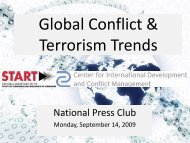Scientific Underpinnings of - START - National Consortium for the ...
Scientific Underpinnings of - START - National Consortium for the ...
Scientific Underpinnings of - START - National Consortium for the ...
Create successful ePaper yourself
Turn your PDF publications into a flip-book with our unique Google optimized e-Paper software.
<strong>National</strong> policy development is likely to be complicated because <strong>of</strong> links between rural-urban<br />
and international migration. Migration is generally a journey <strong>of</strong> hope <strong>for</strong> individuals wishing to<br />
improve <strong>the</strong>ir economic status and enjoy new opportunities. Rapid economic and job growth in<br />
urban areas <strong>of</strong> countries in <strong>the</strong> midst <strong>of</strong> rural-urban migration can provide opportunity <strong>for</strong> most<br />
migrants within borders, as in China and Turkey. Without opportunities within borders <strong>for</strong> those<br />
seeking opportunity, rural-urban migration can become international migration, as from Mexico<br />
to <strong>the</strong> U.S.<br />
Many migrants face difficult trade-<strong>of</strong>fs between economic and o<strong>the</strong>r freedoms—should <strong>the</strong>y<br />
cross national borders <strong>for</strong> higher wages if <strong>the</strong>y lose <strong>the</strong>ir right to engage in political activity to<br />
advocate <strong>for</strong> change in <strong>the</strong> circumstances in which <strong>the</strong>y live and work? The front doors <strong>for</strong> legal<br />
immigrants open widest <strong>for</strong> those with <strong>the</strong> most education and skills, raising questions about<br />
whe<strong>the</strong>r remittances are sufficient compensation <strong>for</strong> a new brain drain. Finally, many developing<br />
countries that are richer than <strong>the</strong>ir neighbors are likely to learn <strong>the</strong> lessons <strong>of</strong> <strong>the</strong> 1960s, viz, that<br />
<strong>the</strong>re is nothing more permanent than temporary workers, and that recruiting or tolerating<br />
migrant workers inevitably adds permanent residents to <strong>the</strong> population.<br />
The world in 2008–09 is in <strong>the</strong> midst <strong>of</strong> <strong>the</strong> most severe recession in half a century, marked by<br />
shrinking economies and rising unemployment. Just be<strong>for</strong>e <strong>the</strong> recession spread around <strong>the</strong><br />
world in 2008, <strong>the</strong> number <strong>of</strong> migrants and remittances were at record levels, and many analysts<br />
expected this growth to continue. Flows <strong>of</strong> labor from poorer to richer countries have slowed and<br />
in some cases reversed due to <strong>the</strong> recession, and it is not clear that migration and remittances will<br />
resume <strong>the</strong>ir upward trajectory during <strong>the</strong> economic recovery.<br />
The current recession could affect migration patterns quite differently than past recessions <strong>for</strong><br />
four major reasons.<br />
First, this global recession began in industrial countries and spread to almost all countries,<br />
limiting <strong>the</strong> ability <strong>of</strong> migrants to shift from lagging to boom areas, as <strong>the</strong>y could when high oil<br />
prices attracted migrants to <strong>the</strong> Gulf countries while doors closed to Western Europe.<br />
Second, <strong>the</strong> effects <strong>of</strong> recession are most severe in cyclically and trade-sensitive sectors such as<br />
construction to manufacturing that hire large numbers <strong>of</strong> migrant workers and may not recover<br />
quickly. Some <strong>of</strong> <strong>the</strong> “migrant jobs” in manufacturing may not return in <strong>the</strong> recovery.<br />
Third, most migrant-sending governments and development institutions have urged migrantreceiving<br />
governments to minimize disruptions to labor migration by stopping recruitment or<br />
<strong>for</strong>cing migrants to leave. (ILO DG Juan Somavia’s December 18, 2008 International Migrants<br />
Day message asked migrant-receiving countries to “assess <strong>the</strong>ir labor market needs be<strong>for</strong>e<br />
resorting to general lay<strong>of</strong>fs <strong>of</strong> migrant workers.” 6 Employers ra<strong>the</strong>r than governments usually<br />
make hiring and lay<strong>of</strong>f decisions; <strong>the</strong> message presumably argues against policies such as that<br />
adopted by <strong>the</strong> Malaysian government, which ordered migrants to be laid <strong>of</strong>f be<strong>for</strong>e Malaysian<br />
workers.) Be<strong>for</strong>e <strong>the</strong> recession, it was widely assumed that migration and remittances would<br />
continue to increase. Current projections anticipate that remittances to developing countries will<br />
decline, but far less than <strong>for</strong>eign direct investment, which is expected to fall sharply. Some<br />
migrant-sending governments have appealed to migrant-receivers to continue accepting migrants<br />
to avoid political unrest among citizens unable to find <strong>for</strong>eign jobs.<br />
The fourth issue is immigration, with <strong>the</strong> issuance <strong>of</strong> about 1.5 million visas a year to people<br />
allowed to settle and eventually naturalize in <strong>the</strong> traditional immigration countries <strong>of</strong> Australia,<br />
25





